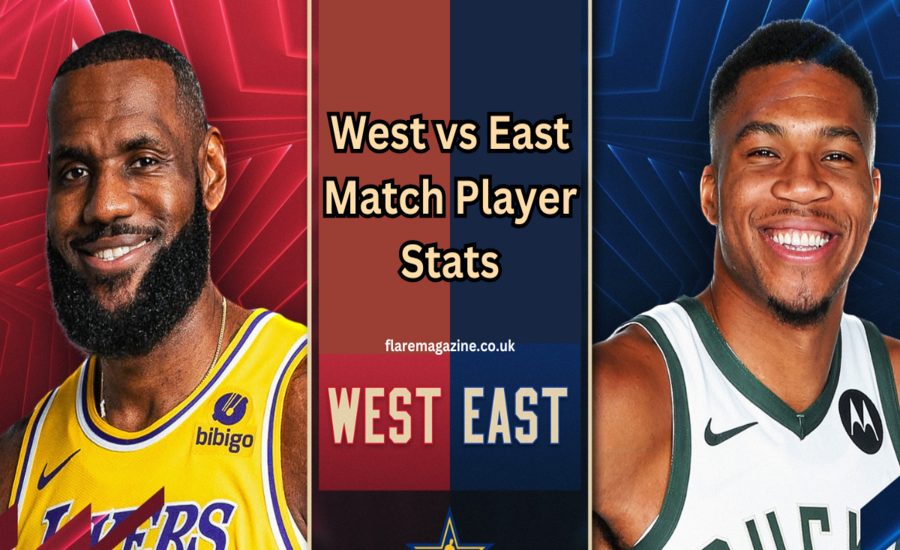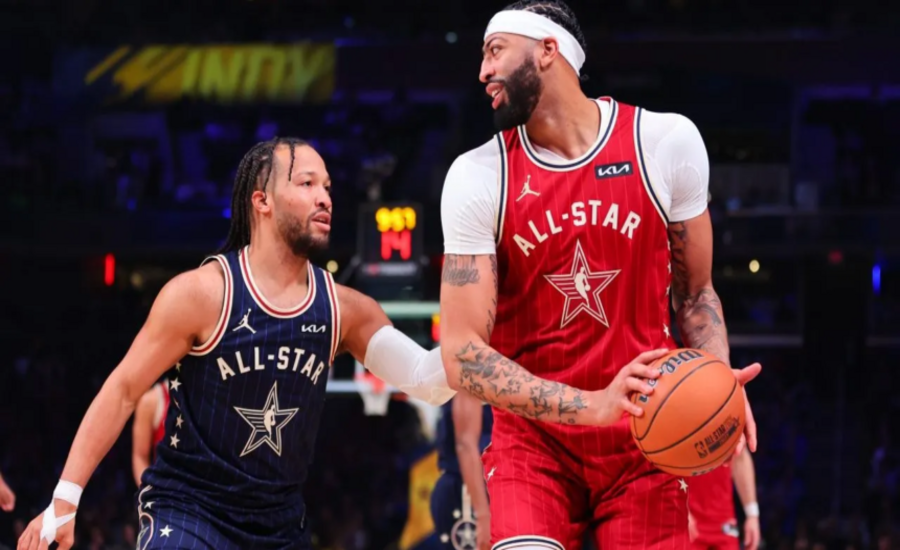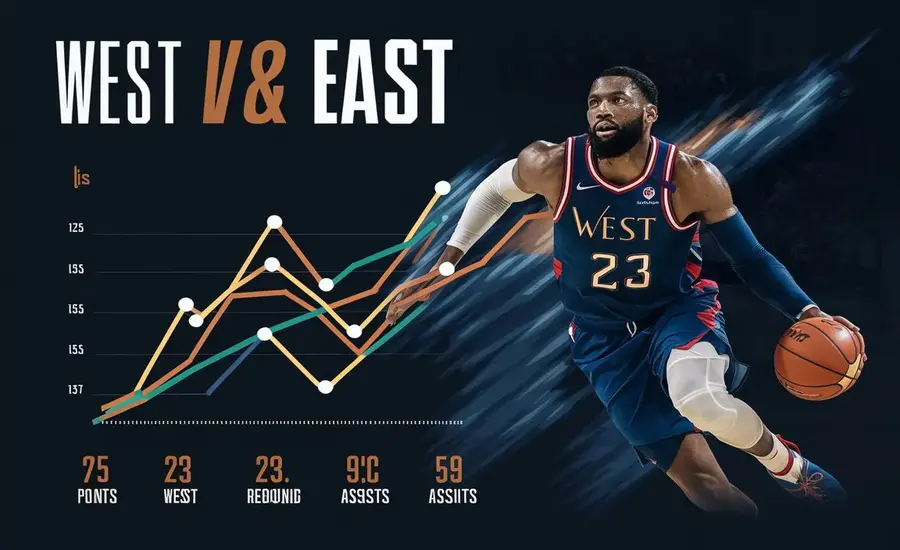The dynamic between the East and West in competitive sports, particularly basketball, has long captivated fans, analysts, and athletes alike. In basketball, the concept of East versus West, with each region represented by its own team or conference, has become synonymous with all-star games and playoff matchups, as well as an overarching rivalry between two regions of a nation. Whether it’s the NBA’s All-Star Game or the highly anticipated conference finals, the discussion of player stats, performance, and potential matchups has always sparked debate. This article will delve into the nuances of player stats in the context of West vs East matches, analyzing key metrics, how different styles of play are reflected in the numbers, and what we can expect in future seasons.

The Historical Context of East vs West in Basketball
Basketball in the United States has been divided into two conferences — the Eastern Conference and the Western Conference — since the NBA’s inception. This division was not only geographical but also strategic, providing a framework for scheduling and playoff formats. Over time, the rivalry between these two conferences evolved into something more symbolic: a clash of contrasting basketball philosophies, player dynamics, and coaching styles. While it is important to acknowledge the changing nature of this rivalry, a comprehensive study of player statistics during West vs East matchups can reveal how these historical differences have influenced individual and team performance.
The Eastern Conference has often been described as the “grit and grind” region, where defense, physicality, and slow-paced games were historically more prevalent. Teams in the East, especially during the 1990s, were known for their rugged defense and half-court offense. Players from the East were often celebrated for their toughness, with names like Patrick Ewing, Alonzo Mourning, and Reggie Miller defining an era where defensive prowess often overshadowed offensive firepower.
On the other hand, the Western Conference has long been associated with fast-paced, high-scoring basketball. The West’s up-tempo style allowed for more fluid offensive schemes, which were often built around perimeter shooting and transition play. This stylistic divide, while not absolute, shaped how fans and analysts viewed matchups between Eastern and Western teams. Players like Magic Johnson, Clyde Drexler, and later, Stephen Curry, have become synonymous with the West’s more open, offensive-driven play.
As the modern game has evolved, many of these distinctions have blurred. Today’s NBA features a more uniform style of play that emphasizes versatility, with an increased focus on three-point shooting and fast breaks across both conferences. However, when we delve into player statistics, we can still find remnants of these historical differences in individual performance metrics.
Key Metrics to Analyze in East vs West Player Matchups
When analyzing player performance in East vs West matchups, a variety of statistics come into play. To comprehensively understand how players perform in these games, it’s essential to focus on key metrics that highlight offensive and defensive capabilities, as well as overall team dynamics. The following are some of the most critical statistics that provide insight into player performance during these high-stakes matchups:
- Points per Game (PPG): This metric represents the average number of points a player scores per game and is often used as a primary indicator of offensive productivity. During East vs West matchups, PPG can give us insight into which conference’s players are more efficient in scoring under the unique pressures of these games.
- Assists per Game (APG): Assists highlight a player’s ability to involve teammates and create scoring opportunities. In West vs East matchups, high assist numbers often indicate a team-oriented approach to offense, especially in games where defenses are particularly tight.
- Rebounds per Game (RPG): Rebounding is crucial for controlling possession. Players with high RPG in these matchups often excel in limiting second-chance points and creating transition opportunities for their team.
- Field Goal Percentage (FG%): This metric represents how efficiently a player is scoring. A high FG% in East vs West games shows that a player is taking smart, high-percentage shots, which is critical in games that often feature strong defenses.
- Player Efficiency Rating (PER): PER is a comprehensive statistic that accounts for a player’s overall productivity on the court. It’s especially useful in East vs West matchups, where the intensity of competition can reveal which players are truly the most impactful, both offensively and defensively.
- Defensive Rating (DRtg): This metric measures a player’s defensive effectiveness, particularly in how well they prevent their opponents from scoring. Players with a strong DRtg in East vs West matchups are typically those who can influence the game beyond just scoring.
- Three-Point Shooting Percentage (3P%): As three-point shooting has become increasingly important in modern basketball, analyzing how players from both conferences perform from beyond the arc is essential. This metric is particularly telling in matchups where perimeter defense can either limit or amplify a player’s shooting prowess.

Eastern Conference vs Western Conference: A Statistical Breakdown
To fully grasp the differences in player performance between the East and West, we must explore how individual statistics have played out historically and in recent seasons. Examining both star players and role players allows us to paint a broader picture of how the two conferences stack up against one another in various statistical categories.
Offensive Performance: Points, Assists, and Efficiency
Offensively, the Western Conference has traditionally produced higher-scoring games. This trend can be observed in player statistics, particularly in points per game and three-point shooting percentages. Players like Kobe Bryant, Kevin Durant, and Damian Lillard have consistently demonstrated offensive prowess, often putting up remarkable scoring performances against Eastern Conference teams. These high-output scorers tend to dominate matchups due to their ability to create their own shot, shoot effectively from deep, and thrive in transition play.
Comparatively, the Eastern Conference, especially during the 2000s, was known for lower-scoring games. However, this doesn’t imply a lack of offensive talent. Players like LeBron James, Dwyane Wade, and Paul Pierce demonstrated their ability to take over games, particularly in clutch moments. The East’s reliance on half-court offense meant that while overall scoring was lower, individual players often carried more offensive load in high-stakes situations.
In terms of assists, the West’s penchant for fast-paced, team-oriented play is reflected in higher average assist numbers. Western Conference teams, particularly those like the Golden State Warriors, built dynasties on ball movement, with players like Steve Nash and Chris Paul excelling as floor generals. Conversely, Eastern Conference players tended to have lower assist numbers, not due to a lack of passing, but because of the slower, more deliberate offensive sets used by teams in this region.
Field goal percentage is another area where differences emerge. Western Conference players often post higher FG% due to their emphasis on efficient shooting and fast-break opportunities. The East, with its slower tempo and reliance on mid-range shots, has historically seen slightly lower shooting percentages, though players like Kevin Garnett and Ray Allen were exceptions to this trend, known for their shooting efficiency.
Defensive Prowess: Rebounds, Blocks, and Defensive Ratings
Defensively, the Eastern Conference has long been associated with a more rugged style of play. This is evident in player statistics such as rebounds per game and blocks per game, where Eastern players have often excelled. Players like Ben Wallace, Dwight Howard, and Joakim Noah have been defensive anchors for their teams, dominating the paint and protecting the rim in East vs West matchups. Their ability to control the boards and disrupt shots has often made the difference in tightly contested games.
In contrast, while the Western Conference has had its share of elite defenders, the emphasis in the West has traditionally been more on offensive production. That said, players like Tim Duncan and Anthony Davis have proven that defensive excellence is not exclusive to the East. These players have posted remarkable defensive ratings in West vs East matchups, showing their ability to impact the game on both ends of the floor.
Rebounding is another key area where Eastern players have historically held an advantage. With the East’s emphasis on physicality and controlling the tempo, players like Shaquille O’Neal and Andre Drummond often dominated the boards, limiting second-chance points for Western teams. However, in recent years, Western Conference teams have begun to close this gap, with versatile big men like Nikola Jokić and Rudy Gobert becoming dominant forces on the glass.

Case Studies: Star Player Matchups in East vs West Games
To truly appreciate the nuances of player performance in East vs West matchups, let’s examine a few key case studies of star player matchups that have defined the rivalry between these two conferences. By looking at their head-to-head stats and performances, we can better understand how individual players thrive or struggle in these games.
LeBron James vs Stephen Curry: The Battle for Supremacy
Few matchups have encapsulated the East vs West rivalry as clearly as LeBron James versus Stephen Curry. Over the course of multiple NBA Finals, these two superstars have gone head-to-head in some of the most memorable games in basketball history. LeBron, the quintessential Eastern Conference player, has relied on his versatility, basketball IQ, and physical dominance to carry his teams to victory. His stats in East vs West games reflect this, with consistently high points, rebounds, and assists.
Stephen Curry, on the other hand, represents the Western Conference’s evolution into a three-point-centric, fast-paced style of play. His shooting prowess and ability to spread the floor have made him one of the most dangerous players in East vs West matchups. Curry’s three-point shooting percentage, combined with his assists, has allowed him to dictate the tempo of games and force Eastern defenses to stretch beyond their comfort zones.
When these two players face off, the stats tell the story of contrasting styles. LeBron’s ability to dominate in the paint and facilitate offense contrasts with Curry’s reliance on perimeter shooting and quick ball movement. These differences make their matchups so intriguing, as each player’s unique strengths are put to the test in high-pressure situations.
Kobe Bryant vs Paul Pierce: Old School East vs West Grit
Another classic East vs West matchup that exemplifies the differences between the two conferences is the rivalry between Kobe Bryant and Paul Pierce. Bryant, representing the West, was known for his scoring ability, footwork, and tenacity. Pierce, the embodiment of Eastern Conference grit, was celebrated for his clutch performances, physicality, and defensive toughness.
In their matchups, Kobe’s offensive brilliance often came to the forefront, with high-scoring games and a remarkable ability to take over in the final moments. Pierce, however, countered with his defensive ability and knack for hitting big shots when it mattered most. Statistically, Kobe often outperformed Pierce in terms of points and shooting percentages, but Pierce’s all-around game and defensive contributions leveled the playing field in many of their encounters.
These matchups were often decided by the smallest of margins, highlighting how individual player stats in East vs West games can reflect broader trends within the rivalry. While Kobe’s offensive prowess was undeniable, Pierce’s ability to step up in key moments exemplified the Eastern Conference’s reliance on defense and mental toughness.
Modern Trends and the Future of East vs West Matchups
In recent years, the traditional distinctions between the Eastern and Western Conferences have started to blur. With the rise of analytics and a greater emphasis on three-point shooting, teams from both conferences have adopted more similar styles of play. However, the rivalry between the East and West remains alive, particularly in the context of All-Star games and the NBA Finals.
One trend that has emerged is the increased versatility of players across both conferences. In the past, Western Conference players were often associated with perimeter play and speed, while Eastern Conference players were known for their physicality and defense. Today, players like Giannis Antetokounmpo and Luka Dončić defy these traditional categories, excelling in multiple aspects of the game and contributing to the convergence of playing styles across the league.
Another key development is the growing international influence on the NBA. Players from Europe, Africa, and Asia have had a profound impact on the league, further blurring the lines between East and West. For example, Nikola Jokić, a Serbian player in the Western Conference, brings a unique skill set that blends traditional post play with advanced passing and shooting abilities. Similarly, Giannis, a Greek player in the Eastern Conference, combines physical dominance with exceptional ball-handling and scoring.
As the game continues to evolve, East vs West matchups will likely become even more exciting, with players from both conferences pushing the boundaries of what is possible on the court. However, one thing remains certain: the rivalry between the two conferences will always provide fans with thrilling games, unforgettable moments, and statistical performances that are worth analyzing for years to come.
Conclusion to West vs East Match Player Stats
The East vs West rivalry in basketball, particularly in the context of player stats, offers a fascinating glimpse into the evolution of the sport. From the contrasting styles of play in the early days of the NBA to the modern game’s emphasis on versatility and three-point shooting, this rivalry has shaped the way we view player performance. By examining key metrics like points per game, assists, rebounds, and defensive ratings, we can better understand how players from each conference excel in these high-stakes matchups.
While the traditional distinctions between the East and West may be fading, the excitement and intensity of these games remain as strong as ever. Whether it’s a star-studded NBA Finals or an All-Star Game showcasing the league’s best talent, East vs West matchups continue to captivate basketball fans around the world. As the game evolves, we can expect new trends, new stars, and new statistical milestones to emerge from this storied rivalry.
More Read: SumoSearch



